What is a verb?
Verb Meaning / Definition
A verb is a doing word that shows an action, an event or a state. A sentence may either have a main verb, a helping verb or both. In other words, a verb is a word that informs about an action, an existence of something or an occurrence. The verb is the main word in a sentence. No sentence can be completed without a verb.
The word ‘verb’ derived from the Latin word ‘verbum‘.
Types of Verbs
- Main Verbs (or Action Verbs)
- Helping Verbs
- Linking Verbs
- – Transitive Verbs
- – Intransitive Verbs
Main Verbs or Action Verbs
Main verbs or action verbs are used to express action; something that an animal, a person or a thing does. In each of the following sentences, we only have a main verb.
- The sun shines.
- The horse neighs.
- The monkey jumps.
Helping Verbs
As the name suggests, helping verbs help or support the main verb.
- We are learning about helping verbs. (are: helping verb; learning: main verb)
- We are in the Green House Club. (are: helping verb)
- You should complete the work by tomorrow. (should: helping verb; complete: main verb)
State of Being Verbs (Linking Verbs)
State of Being verbs state that something ‘is’. State of being verbs also known as linking verbs. Linking verbs explain a link between the subject of the sentence and a noun or adjective being linked to it.
List of Example Sentences
- The flowers are bright.
- Diamond is the hardest substance.
- I feel scared.
Understanding Verbs
The words: am, is, are, was, and were, belong to the verb “to be”. We use ‘am’ or ‘was’ with the pronoun ‘I’. We use ‘is’ or ‘was’ when the subject of the sentence is singular. We use ‘are’ or ‘were’ when the subject of the sentence is plural.
List of Example Sentences
- I was late for school yesterday.
- I am twelve years old.
- She is a wonderful singer.
- These questions are difficult.
- He was planning to meet the doctor.
- The Hollywood actors are famous.
- They were winners last year.
- It is a great feeling to win the trophy.
We use ‘is‘ with singular nouns and pronouns ‘he, she, it‘.
List of Example Sentences
- My school is near my house.
- This restaurant is closing down.
- She is writing a postcard.
- Dog is a faithful animal.
- Ottawa is the capital of Canada.
- He is acting strange today.
We use ‘are‘ with plural nouns and pronouns ‘we, you, they‘.
List of Example Sentences
- The balloons are colourful.
- They are best friends.
- The kites are flying high in the sky.
- They are planning to go by train.
- We are going to win the match.
- You are writing so untidily!
We use ‘are‘ when we join two or more nouns.
List of Example Sentences
- John and Sam are brothers.
- Joseph and we are neighbours.
- Anne and Sue are enjoying the play.
- Sharon and Jenny are competing for the gold medal.
- Mrs. and Mr. Lee are planning to visit New Zealand.
Subject-Verb Agreement
It is very important to take care of the subject and verb agreement while framing a sentence. It is very important that a verb must be compatible and agree with its subject to make a correct and valid sentence.
Let us understand with the help of an example.
If we write:
- Phil is playing with a ball. (Correct)!
- Phil are playing with a ball. (Incorrect) X
In the first sentence, the subject (Phil) is singular, so we need a singular verb (is playing). The sentence is correct. In the second sentence, the subject (Phil) is singular, but the verb is plural (are playing). The sentence is incorrect.
Rules of Subject-Verb Agreement
Rule 1 – Subject-Verb agreement with a singular noun
If the subject is a singular noun or a pronoun (he, I, she, it), we must ensure that we use a singular verb to write a correct sentence.
List of Example Sentences
- She is playing the guitar.
- The postman is asking for your signature.
- The movie has caught everyone’s attention.
- Does he know the minister well?
- She is cheering the team.
- He enjoys music.
- My mom drives carefully.
- The moon revolves round the earth.
- Is it raining?
Rule 2 – Subject-Verb agreement with plural noun
If the subject is plural (we, they, those, you), we need a plural verb to write a correct sentence.
List of Example Sentences
- The boys were dancing in the corridor.
- The children are playing in the garden.
- The students were writing their exam.
- Two of our girls have won the quiz.
- We have finished our homework.
- Both the boys have worked hard.
- Philip and Luke are swimming.
- The teachers are correcting the answer sheets.
- Farmers work in the fields.
Rule 3 – Subject-Verb agreement with collective nouns
The collective nouns are considered as singular. We use singular verbs with them.
List of Example Sentences
- The crowd was very noisy.
- Our team has to win the match.
- The audience is having a gala time.
- The band is playing the school song.
- The choir is singing beautifully.
- My family is from Poland.
- Our cricket team is the best in the whole town.
- A bouquet of flowers was presented to the chief guest.
Rule 4 – Subject-Verb agreement with ‘either/or’ or ‘neither/nor’
The verb must agree with the noun or the pronoun that is closer to ‘either/or’ or ‘neither/nor’.
List of Example Sentences
- Neither he nor I am guilty.
- Neither Bob nor his friends want the party.
- Either you or your sister is telling a lie.
- Either Nancy or Mary is typing the letter.
- Neither Julia nor her parents know the way to the passport office.
Rule 5 – Subject-Verb agreement with indefinite pronouns
Indefinite pronouns like ‘nobody’, ‘everybody’, ‘someone’, ‘somebody’, ‘one’ are always singular.
List of Example Sentences
- Everybody is liking the new car.
- Someone is calling for you.
- Nobody is allowed to enter that room.
- Everybody likes Mrs. Ola, the new History teacher.
- One of the passengers was asking for tomato soup.
- Somebody is knocking at the door.
Rule 6
We use singular verbs for uncountable nouns.
List of Example Sentences
- There is sufficient food in the refrigerator.
- Cold weather is a problem in this part of the country.
- Sugar is yet to get over in the container.
- Salt is obtained from sea water.
- Milk with cornflakes is one of my favourite breakfast options.
Rule 7
A plural noun takes a singular verb when it is a name such as Paris, China, Arabian Nights, and so on.
- China is the most densely populated country.
- Norway is a very cold country.
- ‘The Power of Positive Talk’ is a good book.
Types of Action Verbs
There are two types of action verbs:
- Transitive Verbs
- Intransitive Verbs
Transitive Verbs
A transitive verb expresses an action directed towards a person, place or thing. The action expressed by a transitive verb passes from the doer or the subject to the receiver of the action. Words that receive the action of a transitive verb are called objects.
For example:
- The teacher made the question paper.
- Peter cut the cake.
In the above two sentences, we can see that the words in green colour ‘the question paper‘ and ‘the cake‘ complete the sense of the sentence or work as objects. The two sentences would not make complete sense without the objects.
- The teacher made ……………….. what? (the question paper)
- Peter cut ……………….. what? (the cake)
In the above sentences, the verbs ‘made‘ and ‘cut‘ are transitive verbs. A transitive verb needs a direct object to complete its meaning.
Example Sentences of Transitive Verb
- Birds have feathers.
- The teacher praised the pupil.
- She is eating a pear.
- I like English.
- They are playing football.
- The potter has made a beautiful pot.
- Dennis bought a bicycle.
- She is writing an essay.
Intransitive Verbs
A verb which does not need an object to make complete sense is called an intransitive verb. An intransitive verb expresses action (or tells something about the subject) without the action passing to a receiver or object. It can stand alone in the predicate because its meaning is complete.
Example Sentences of Intransitive Verb
- Mr. Becker jogs every day.
- The wicked hunter was hiding.
- Anne looks very beautiful.
- Mr. John speaks loudly.
- The ship sank rapidly.
- The department store opens at six o’clock.
- Mr. Ben is driving carefully.
- The wind blew strongly.
Interesting Grammar Facts about Verbs
To determine if a verb is transitive, ask yourself ‘Who?’ or ‘What?’ after the verb. If you can find an answer in the sentence, the verb is transitive.
Some verbs are always intransitive, such as: to snore or to fall. It is incorrect to say: She snores her nose.
For example: She snores a lot. In this example ‘a lot’ is not an object but an adverb. It doesn’t represent what the person snores but rather how or how much she snores.
Some verbs are always transitive, such as to recognise or to merit. It is somewhat incorrect to say: “Ah, yes, I recognise” or she certainly does merit.
Double Object
Some transitive verbs have two objects. Those things that you do for someone or you give to someone are called direct objects. The person who receives the thing is called the indirect object.
Examples of Double Object
- The manager gave her the money.
- Mother is reading Michael a story.
- Nancy baked a cake for me.
- Can you fetch me a cup and a plate?
In above examples:
- Verbs: ‘gave, reading, baked and fetch’.
- Indirect object: ‘her, Michael, me, me’.
- Direct object: ‘money, story, cake, cup and a plate’.
VERBS
We have the following:
,
— Notes and Videos
— Exercises with Answers
NOTES
The Definitions of Verbs
— A verb is
a word or a combination of words that indicates action or a state of being or
condition.
— A verb is
a doing word that shows an action, an event or a state.
— A verb is
the part of speech that indicates what something does, or what it is.
— A verb is
a word used to describe an action, state, or occurrence, and forming the main
part of the predicate of a sentence, such as hear, become, happen.
— A verb can
be defined as a word that expresses an action or a state of
being.
— Verbs are
the action words in a sentence that describe what the subject is doing.
— A verb
is a word or phrase that describes an action, condition, or experience:
«Run,» «keep,» and «feel» are all verbs.
NOTES 1
A verb is a word that we use to refer to actions (what things do) and states of being (how things are). For example, the words describe, eat, and rotate are verbs.
As you are about to see, verbs come in a lot of different types that don’t all behave the same way. When using proper grammar, it is important that you use verbs correctly.
So, we are going to explore the many different types of verbs that we use and how to successfully use them to create great, clear sentences.
Types of Verbs
We are going to explore 11 different types of verbs. Because every type deserves some attention, we won’t be going into too much detail on each type. If you want to learn more than what is covered here, you’re in luck. Listed below are each of the 11 types of verbs we are going to look at and a link to an article entirely focused on that specific type of verb.
- Action verbs
- Stative verbs
- Transitive verbs
- Intransitive verbs
- Linking verbs
- Helping verbs (also called auxiliary verbs)
- Modal verbs
- Regular verbs
- Irregular verbs
- Phrasal verbs
- Infinitives
1. Action verbs
Action verbs, as their name says, are used to refer to actions. These can refer to physical actions that are performed with bodies or objects, such as jump, hit, or sing, or mental actions that we use our brains to perform, such as think, consider, or memorize. Most verbs you will find are action verbs.
List of action verbs
- run
- swim
- help
- ignore
- believe
Examples of action verbs in a sentence
Each of these sentences uses action verbs. You’ll see that each verb is referring to a physical or mental action.
— I work at a factory.
— Cats chase mice.
— We listened to the woman’s amazing story.
2. Stative verbs
Unlike action verbs, stative verbs refer to conditions or states of being. Generally speaking, we use stative verbs to describe things like qualities, states of existence, opinions, beliefs, and emotions. When used in a sentence, stative verbs do not refer to actions. It is important to know that some verbs can be used as either action or stative verbs depending on their meaning in the sentence. We are less likely to use stative verbs in the continuous verb tenses.
List of stative verbs
- love
- want
- own
- have
- resemble
Examples of stative verbs in a sentence
These sentences all use stative verbs. You’ll notice that none of these verbs refer to actions.
— The mansion has five bathrooms.
— Allie loves her younger sisters.
— My car needs an oil change.
3. Transitive verbs
A transitive verb is a verb that is accompanied by a direct object in a sentence. The direct object is the noun, pronoun, or noun phrase that is having something done to it by the subject of the sentence. Both action and stative verbs can have direct objects, which means they can both be used as transitive verbs.
Examples of transitive verbs in a sentence
The following sentences all contain examples of transitive verbs. As you read each one, consider what the direct object of the sentence is.
— Leonardo ate a delicious pepperoni pizza.
— The wealthy man bought three paintings.
— She really hates broccoli.
4. Intransitive verbs
The opposite of a transitive verb is an intransitive verb. A verb is an intransitive verb if it is not used with a direct object. Remember, only nouns, pronouns, and noun phrases can be direct objects. Prepositional phrases, adjectives, and adverbs cannot be used as direct objects. Once again, both action and stative verbs can be used as intransitive verbs.
Examples intransitive verbs in a sentence
Each of these sentences uses intransitive verbs. Look carefully and you will see that none of these sentences have direct objects.
— Airplanes fly.
— The children slept while the adults worked.
— The terrified monkeys hid in the trees after they saw the gigantic hungry snake.
5. Linking verbs
Linking verbs are a special type of stative verb whose name gives a big clue as to what they do. Linking verbs are used to link a subject with a subject complement. A subject complement describes or identifies the subject of the sentence or clause. Linking verbs can function as intransitive verbs, which do not take direct objects.
List of words used as linking verbs
- be
- become
- seem
- appear
- grow
Examples of linking verbs in a sentence
In each of the following sentences, linking verbs are used to link a subject with a subject complement.
— Mike is a great dancer.
— That gold watch looks expensive.
— Suddenly, the mall got really crowded.
6. Helping verbs (auxiliary verbs)
Helping verbs, also called auxiliary verbs, are helpful verbs that work with other verbs to change the meaning of a sentence. A helping verb combines with a main verb in order to accomplish different goals. These include changing the tense of the verb or altering the mood of a sentence.
List of words used as helping verbs
- be
- have
- do
- can
- will
Examples of helping verbs in a sentence
Each of the following sentences uses a helping verb. Take a moment to consider what each sentence is saying and how a helping verb contributes to the meaning of the sentence.
— The musician has performed in concerts all over the world.
— My cat is getting slow in her old age.
— Cheetahs can run incredibly fast.
7. Modal verbs
Modal verbs are a subgroup of helping verbs that are used to give a sentence a specific mood. Each modal verb is used differently, and they can express concepts such as ability, necessity, possibility, or permission.
List of verbs used as modal verbs
- can
- may
- might
- must
- would
Examples of modal verbs in a sentence
The following sentences all use modal verbs to express a certain tone. You’ll see that each sentence would have a different meaning (or wouldn’t make sense) without the modal verb.
— Once you finish your homework, you may play outside.
— We must carefully add two eggs to the mixing bowl.
— I would go to the movies if I wasn’t busy working.
8. Regular verbs
A verb is considered a regular verb if its past tense form and past participle ends in -ed, -d, or the verb is a -t variant verb. For example, the verb look is a regular verb because both its past tense form and past participle is looked. Sometimes, regular verbs may slightly change spelling. For example, the past tense and past participle of cry is cried.
List of regular verbs
- jump becomes jumped
- slip becomes slipped
- try becomes tried
- sleep becomes slept
- lend becomes lent
Examples of regular verbs in a sentence
Each of the following sentences use regular verbs in either their past tense form or as a past participle.
— He walked two miles to the post office.
— We purchased all of the supplies that we needed for the camping trip.
— Tiffany had noticed something strange about Marcus’s story.
9. Irregular verbs
An irregular verb is a verb whose past tense and past participle form doesn’t end in -ed, -d, and doesn’t use the –t variant. Often, the spelling of these verbs changes dramatically or may not even change at all.
List of irregular verbs
- be becomes am, is, are, was, were, be, being, and been
- eat becomes ate, eaten
- fly becomes flew, flown
- catch becomes caught, caught
- set becomes set, set
Examples of irregular verbs in a sentence
The following sentences use irregular verbs. Despite being used in the past tense or as a past participle, none of these verbs end in -ed, -d, or are a -t variant verb.
— Cindy knew all of the right answers.
— This junky computer has given me nothing but headaches since I bought it.
— The workers took the furniture out of the moving truck.
10. Phrasal verbs
Phrasal verbs are combinations of a verb with prepositions and/or adverbs that have a different meaning from the individual words used to form them. For example, the verb shut means “to close,” and the adverb down means “not up” or “in a descending direction.” However, the phrasal verb shut down means to stop the operation of something.
List of phrasal verbs
- ask for
- put up with
- talk down to
- lock up
- cut across
Examples of phrasal verbs in a sentence
The following sentences show how we can use phrasal verbs. Sometimes, we can separate out the words of a phrasal verb and the sentence is still grammatically correct.
— The frustrated business owner closed down his store.
— Dave loves to show off his baseball trophies.
— My mother always told me it is a good idea to put some money away in case of emergencies.
11. Infinitives
Our last type of verb isn’t actually a verb at all—sorry about that! However, infinitives look a lot like verbs because they are derived from them. An infinitive of a verb is identical to the base form of the verb. For example, the infinitive form of the verb open is open. Typically, we use infinitives with the word to in order to form infinitive phrases. Infinitive phrases can be used for a variety of reasons, such as to act like nouns, adjectives, or adverbs.
Examples of infinitive phrases in a sentence
All of the following sentences use infinitive phrases. In order, the infinitive phrases are acting as a noun (nominal infinitive), an adjective (adjectival infinitive), and an adverb (adverbial infinitive).
— To play guitar in a rock band is my goal.
— If you are looking for the best restaurants in town, Luis is the person to ask.
— The writing in the letter was too small to see.
NOTES 2
What is a verb? Verbs are words that describe actions, whether
physical or mental. Verbs also describe a “state of being,” like the verbs be,
become, or exist.
Salah ran across the field, kicked the ball, and scored a goal.
“I am the State.” — King Louis XIV
Some verbs also act as “helper verbs” to change the tense of another verb. Likewise, these helper verbs can change a positive statement to a negative one with words like “not.”
She has been jogging for a month and already feels her stamina increasing.
“I don’t feel so good.” — Spider-Man
Types of verbs
Dynamic (action) verbs
Most verbs describe a physical action or activity, something external that can be seen or heard. These verbs are formally known as dynamic verbs, but can also be called action or event verbs.
Examples: walk, laugh, swim, play, eat, drink, sing, dance, talk, say
There are a lot of actions that take place in our minds and feelings, which are not external. Verbs that describe mental or internal actions are still dynamic verbs, but they’re not always so obvious. These include “process verbs,” which describe actions of transition.
Examples: consider, guess, change, grow, live, endure, succeed, fail
Stative (state-of-being) verbs
The opposite of dynamic verbs of action is stative verbs of being. Stative verbs describe a subject’s state or feeling, including things they like and don’t like.
Examples: want, need, prefer, love, hate, like, dislike, seem, understand, know, believe, involve, realize
One of the most important parts of stative verbs is that you can’t use them in the continuous tenses. Stative verbs stick to the simple tenses, or occasionally use the perfect.
The trouble is that some verbs can be dynamic or stative, depending on the specific meaning and how they’re used. This includes the most popular verb be. Let’s take a deeper look at these.
Verbs that can be dynamic or stative
A lot of verbs have more than one meaning, so they can be used as dynamic or stative. These include perception words: see, hear, taste, smell, feel.
When perception verbs are used as an involuntary action, such as passive or unintentional actions, they are stative. This applies when these verbs are used in the general sense, a state of being that’s always happening.
I can’t see without my glasses.
Cake still tastes great even if it’s not your birthday.
When those same verbs are used for a voluntary action—specific, deliberate, and/or temporary events—they are dynamic. Among other things, it means they can be used in the continuous tenses.
I haven’t been seeing well since I lost my glasses.
We were tasting cakes for the wedding all afternoon.
Likewise, some perception verbs have alternative meanings, especially if they’re part of expressions or phrasal verbs. Often, this means they act as dynamic verbs.
Romeo and Juliet had been seeing each other for just five days when they died.
Other verbs, like think, have, and, above all be, follow the same voluntary/involuntary rules as perception verbs. Depending on how they’re used, they can be either dynamic or stative.
I think toads are better than frogs.
(stative: expresses an opinion or feeling always there; involuntary)
All morning I was thinking about how toads are better than frogs.
(dynamic: expresses the temporary action of thinking; voluntary)
I have a ten-year-old dog.
(stative: expresses permanent ownership; involuntary)
I am having a party for my dog’s eleventh birthday.
(dynamic: used as part of phrase; voluntary)
He is nice to everyone.
(stative: expresses an ongoing state or personality trait; involuntary)
He was just being nice to everyone to get a promotion.
(dynamic: expresses a temporary/intentional state; voluntary)
Auxiliary (helping) verbs
Auxiliary verbs, or “helping verbs,” are used in English to change another verb’s tense, voice, or mood. When auxiliary verbs are used, there’s always a main verb that represents the main action. However, the auxiliary verb must still be conjugated correctly.
The main auxiliary verbs are be, have, and do. We explain how they’re used specifically for conjugating below, but here are a few quick examples:
I have eaten sushi many times before. (tense)
That piece of sushi was eaten by me. (voice)
Did you eat my sushi? (mood)
Modal auxiliary verbs
Some auxiliary verbs are added to another verb to show necessity, possibility, or capability. Like other auxiliary verbs, modal auxiliary verbs are not the main verb, but they do change its meaning slightly. Some common examples are can, may, could, should, would, must, ought, and might.
I could swim across the English Channel, but should I do it?
She must be the strongest person on the team, and might be the strongest person in the region.
Phrasal verbs
Phrasal verbs are phrases that act as individual verbs, often combining two or more words and changing their meaning. The verb get, for example, becomes many different phrasal verbs when combined with different prepositions.
When the bus stops, passengers get out on the sidewalk.
After losing his job, he’s getting by on savings.
The important thing to remember about phrasal verbs is that they act as a single verb, so you can still use them with other verbs and prepositions. However, when you conjugate a phrasal verb, you only conjugate the part of the phrase that’s actually a verb, like get.
Verb categories
Aside from the different types, verbs also come in different categories. Dynamic, stative, and auxiliary verbs all make up the categories below.
Transitive, intransitive, and ditransitive
Transitive, intransitive, and ditransitive refer to how a verb acts with direct and indirect objects. A direct object is the person or thing that the action happens to, while an indirect object is the person or thing that receives the direct object.
Lindor threw the ball to deGram.
In this example, the subject is Lindor and the verb is threw. The direct object is the ball because that is what was thrown—Lindor did the action to the ball. The indirect object is deGram because he received the direct object, the ball.
Verbs that don’t use either a direct or indirect object are called intransitive. These verbs are complete actions by themselves.
Examples: go, walk, run, talk, sit, sleep, work
Verbs that use a direct object, but not an indirect object, are called transitive. They don’t always need a direct object, but they have the option.
Examples: clean, like, love, dislike, hate, want, learn, deserve, say
Verbs that use both direct and indirect objects are called ditransitive. They don’t always need an indirect object, but they have the option.
Examples: throw, make, buy, sell, read, give, lend, bring
Just as a verb can be either dynamic or stative depending on the meaning, a verb can sometimes act transitive while at other times act intransitive. These are known as ambitransitive. For example, if you ask someone if they’re hungry, they might respond:
No, I already ate. (intransitive)
No, I already ate a sandwich. (transitive)
Active vs. passive voice
In English, the standard format where the subject performs the action is known as the active voice. However, you can switch around your words to make the direct or indirect objects the subject of the sentence, known as the passive voice. You can make a verb passive by adding a conjugated form of be in front of its past participle.
Stricklen threw the ball to Williams. (active)
The ball was thrown to Williams by Stricklen. (passive)
Williams was thrown the ball by Stricklen. (passive)
Linking (copular) verbs
A linking verb is any verb, dynamic or stative, that directly connects or “links” the sentence’s subject to other words in the sentence. For example:
Garfield is a cat.
Here, “Garfield” and “a cat” are the same thing, so “is” acts as a linking verb.
A linking verb—also known as a copula or copular verb in formal linguistics—connects the subject not just to other nouns and adjectives, but also to prepositional phrases and other verbs in the infinitive form. Although the verb be is the most-used linking verb in English, other linking verbs like seem and become are also common.
Garfield is in the kitchen.
Garfield became fat by eating lasagnas.
Garfield seems to hate Mondays.
Likewise, perception verbs are often linking verbs as well, but only when they describe what is being perceived.
The mild sauce also tastes spicy.
Birds look happy when the sun comes out.
The student felt pride when they used perfect grammar.
Regular vs. irregular Verbs
Verbs have different forms to show different uses, such as an action that happened in the past, or an action that happens continuously. Normally, these forms follow the same patterns of conjugation, so that you can use the same rules on all verbs. Verbs that use the normal forms are regular verbs.
Unfortunately, some verbs don’t want to play by the rules. They have their own unique forms with no patterns, specifically for the simple past tense and past participle forms. These are the notorious irregular verbs, and there are quite a few of them—including the most common verb be.
To make matters worse, the only way to learn how to use irregular verbs is to study them and all their forms. But first, you’ll want to learn the standard verb forms of the majority regular verbs below.
Verb Forms
Verbs can be said to have five forms in English: the base form,
the present tense form (which may include
the agreement ending -s), the past tense form,
the present participle, and the past participle. Although the forms
are predictable for most verbs in English, many common verbs have one or more
unpredictable or irregular forms.
Forms of the Verb Study
— Base form: study
— Present tense form: studies
— Past tense form: studied
— Present participle: studying
— Past participle: studied
VIDEOS
Watch the following Videos:
VIDEO 1
VIDEO 2
VIDEO 3
VIDEO 4
EXERCISES
with
ANSWERS
>> Verb Exercises with Answers
: a word that characteristically is the grammatical center of a predicate and expresses an act, occurrence, or mode of being, that in various languages is inflected for agreement with the subject, for tense, for voice, for mood, or for aspect, and that typically has rather full descriptive meaning and characterizing quality but is sometimes nearly devoid of these especially when used as an auxiliary or linking verb
transitive verb
: to use (a word and especially a noun) as a verb : to make (a word) into a verb
A television announcer in Vero Beach, Fla., spoke of a promise «to upkeep the beach,» thus verbing a word that had been in use as an honest noun since 1884.—
But it is by no means unusual for a noun to be verbed.—
Did you know?
Verbs are words that show an action (sing), occurrence (develop), or state of being (exist). Almost every sentence requires a verb. The basic form of a verb is known as its infinitive. The forms call, love, break, and go are all infinitives.
Almost all verbs have two other important forms called participles. Participles are forms that are used to create several verb tenses (forms that are used to show when an action happened); they can also be used as adjectives. The present participle always ends in -ing: calling, loving, breaking, going. (There is also a kind of noun, called a gerund, that is identical in form to the present participle form of a verb.) The past participle usually ends in -ed, but many past participles have irregular endings: called, loved, broken, gone.
The verb’s past tense usually has the same -ed form as the past participle. For many verbs, however, the past tense is irregular. An irregular past tense is not always identical to an irregular past participle: called, loved, broke, went.
The two main kinds of verbs, transitive verbs and intransitive verbs, are discussed at the entries for transitive and intransitive.
Example Sentences
Recent Examples on the Web
Today, their DocuSign Global Trust Network has 1 billion users and 1 million companies, and the name of the company has become a verb.
—
Few people actually use it as a verb in everyday language.
—
What was once a valuable way of characterizing particular abuse became generic slang in our ongoing debates, the filler attack verb in any disavowal of an individual or institution.
—
Ski-Doo is a brand of snowmachine, but it’s also become a generic verb for riding.
—
Confit is a French verb traditionally meaning* to cook food in its own fat.
—
Traditional teaching methods, like asking students to conjugate a verb on the spot or translate a complex Latin passage in front of their peers, can be tedious at best and nail-bitingly nerve-racking at worst.
—
Derived from an active verb, it’s used in the passive voice in pretty much every statement.
—
The idiom’s hoist is the past tense of an older verb that is now obsolete: hoise (sometimes spelled and pronounced hyse).
—
See More
These examples are programmatically compiled from various online sources to illustrate current usage of the word ‘verb.’ Any opinions expressed in the examples do not represent those of Merriam-Webster or its editors. Send us feedback about these examples.
Word History
Etymology
Noun
Middle English verbe, borrowed from Anglo-French, borrowed from Latin verbum «word, verb» — more at word entry 1
First Known Use
Noun
14th century, in the meaning defined above
Verb
1928, in the meaning defined above
Time Traveler
The first known use of verb was
in the 14th century
Dictionary Entries Near verb
Cite this Entry
“Verb.” Merriam-Webster.com Dictionary, Merriam-Webster, https://www.merriam-webster.com/dictionary/verb. Accessed 13 Apr. 2023.
Share
More from Merriam-Webster on verb
Last Updated:
28 Mar 2023
— Updated example sentences
Subscribe to America’s largest dictionary and get thousands more definitions and advanced search—ad free!
Merriam-Webster unabridged
Слайд 2What is a verb?
A verb is a word that shows an
action or state of being. In other words, they explain what something is or is doing.
He ran quickly. (action) He is happy. (state of being)
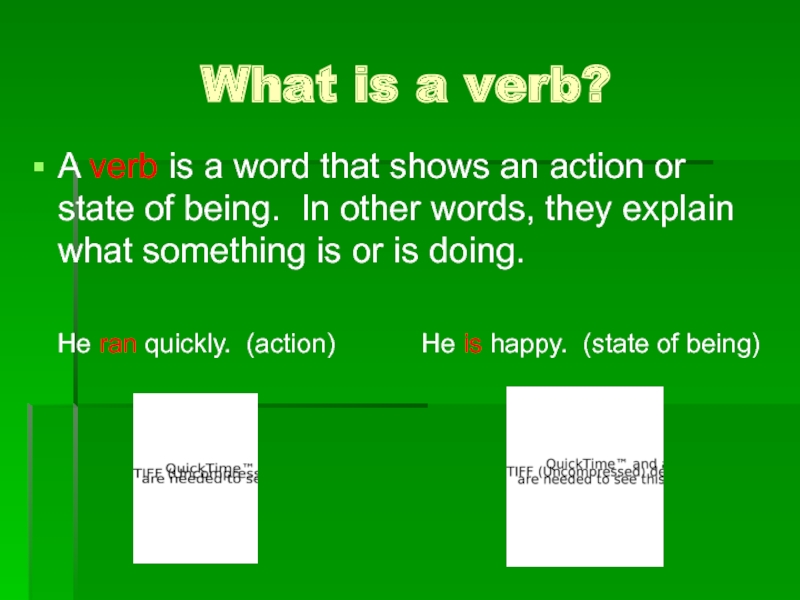
Слайд 3There are many kinds of verbs. Here are some I want
you to know
Action and Linking Verbs
Helping and Main Verbs
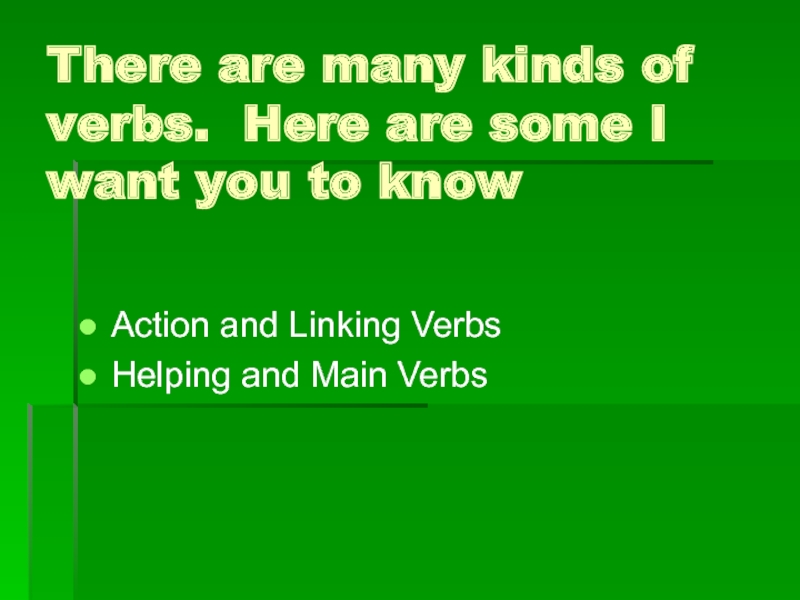
Слайд 4Action Verbs
An action verb shows action. It shows what someone (or
something) is doing.
Example: The boy swam in the lake.
(Swimming is an action.)

Слайд 5Linking Verbs
A linking verb connects the subject to a word (or
words) that are describing the subject
The man is funny.
(Man is being linked to the descriptive word funny.)
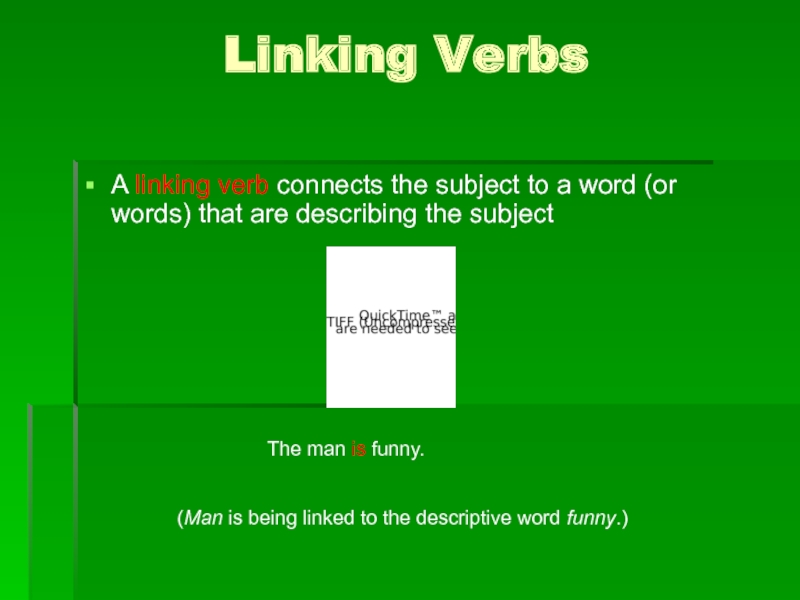
Слайд 6Commonly Used Linking Verbs
Forms of Be:
Other Verbs:
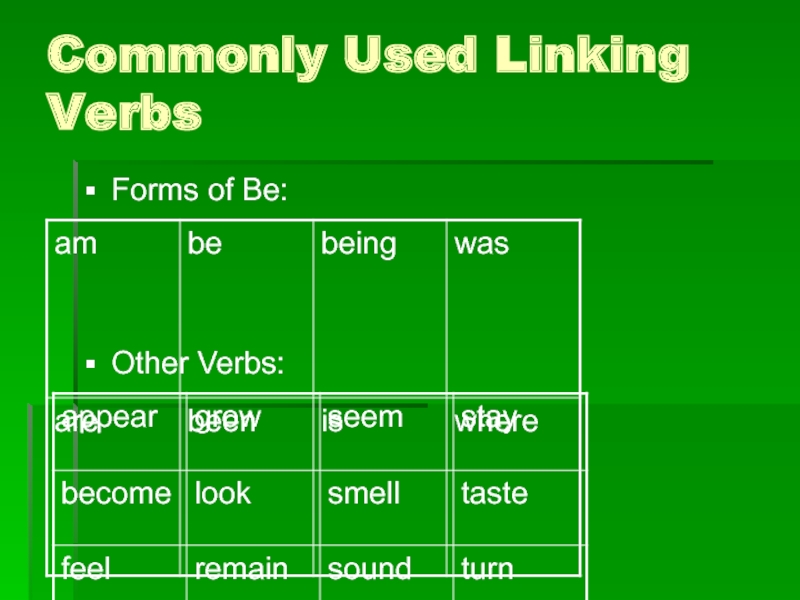
Слайд 7Action or Linking?
To find out if a verb is an action
or linking verb, substitute a form of be for the verb. If the sentence still makes sense, it’s usually a linking verb. If the sentence doesn’t make sense, it’s usually an action verb.
Note: Forms of be and seem are always linking verbs
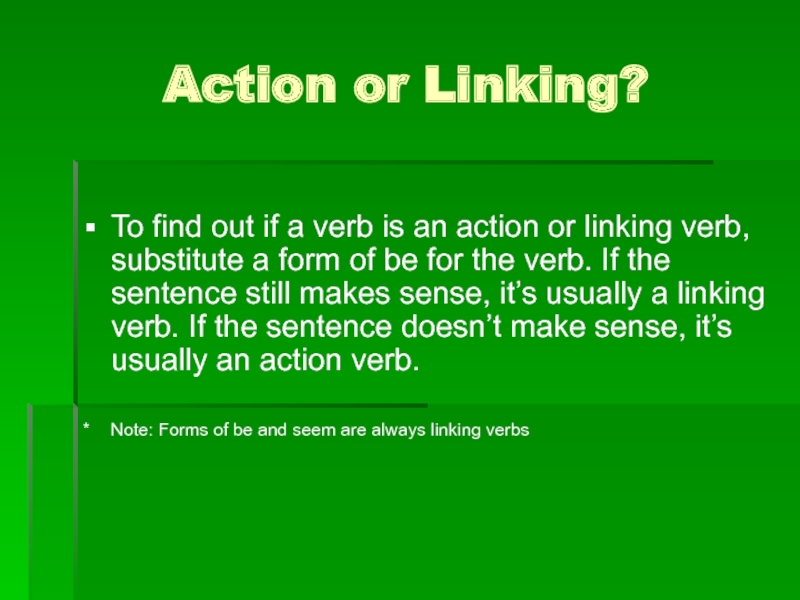
Слайд 8Action vs. Linking Verb Examples
Joe plays baseball.
Joe is baseball. (The sentence
does not make sense, so it is an action verb.)
The roses look pretty.
The roses are pretty. (The sentence makes sense, so it is a linking verb.)
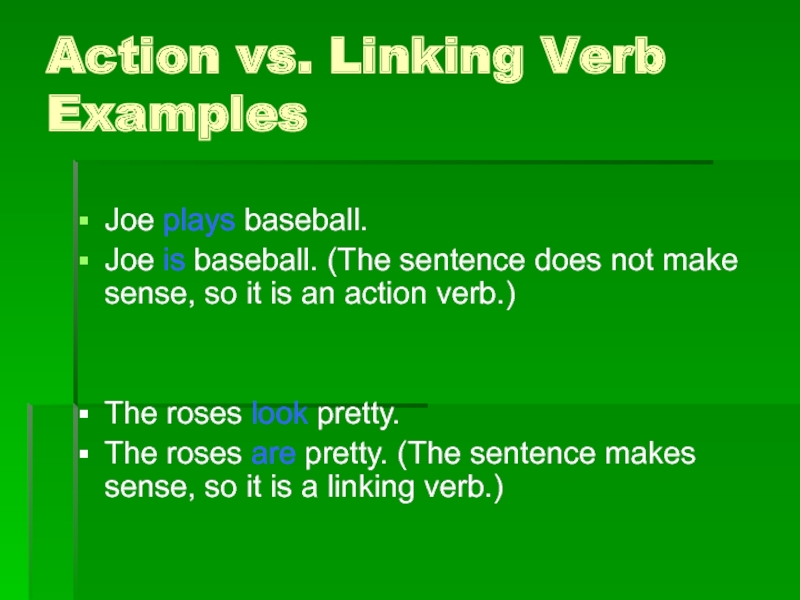
Слайд 9Main Verbs
Some sentences have several verbs working together to mean one
thing. The main verb is the verb that’s most specific about what the subject is or is doing.
The girl could have gone to the zoo.
The dog may eat dinner soon.
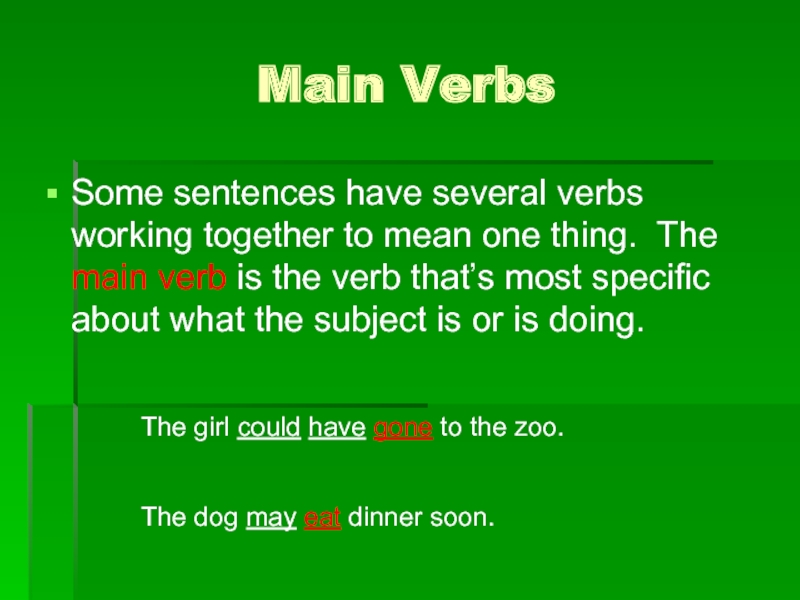
Слайд 10Helping Verbs
When sentences have several verbs working together, the helping verbs
are the verbs that are helping the main verb.
The girl could have gone to the zoo.
The dog may eat dinner soon.
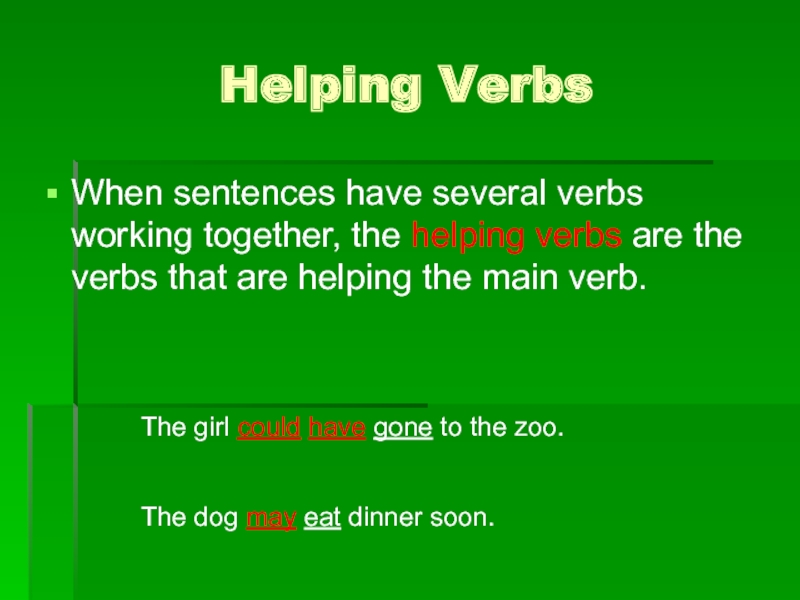
Слайд 11A List of Helping Verbs…
am, are, is, was, were, be, being,
been, do, does, did, shall, will, may, must, might, have, has, had, can, could, would, should
Note: Some helping verbs can also be linking verbs. How do you know which is which? You have to see how they’re being used in the sentence.
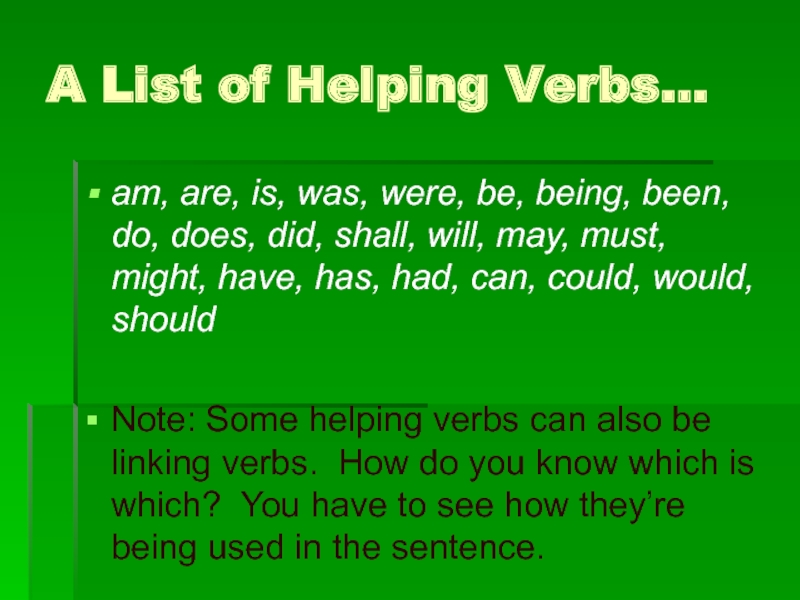
Слайд 12Helping or Linking Verb?
The boy is funny. (This is a linking
verb because boy is being linked to the descriptive word funny.)
The boy is running. (This is a helping verb because is helps running make sense.)
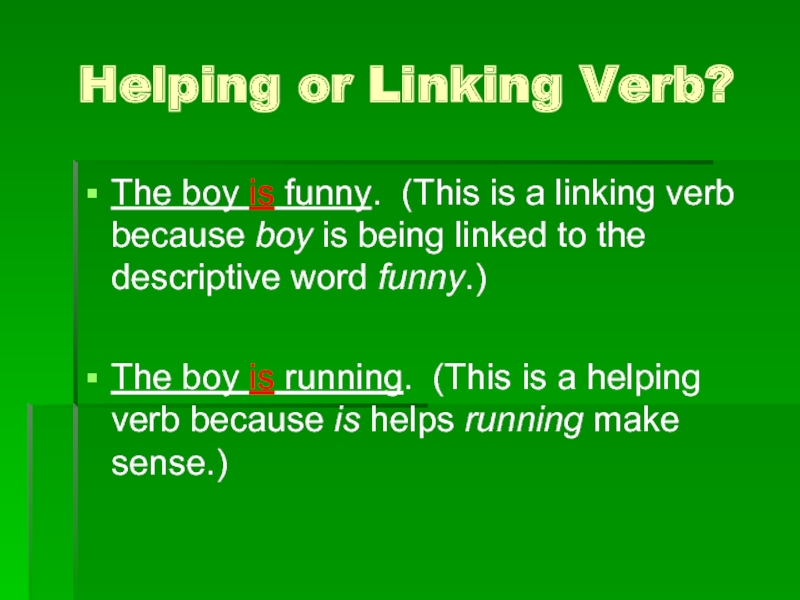
Слайд 13An Easy Tip to Remember
When trying to decide if a word
is a helping verb or linking verb, ask yourself these two questions:
Are there other verbs in the sentence?
Is this verb helping the other verbs make sense?
If the answer to these questions is yes, than you have a helping verb on your hands.
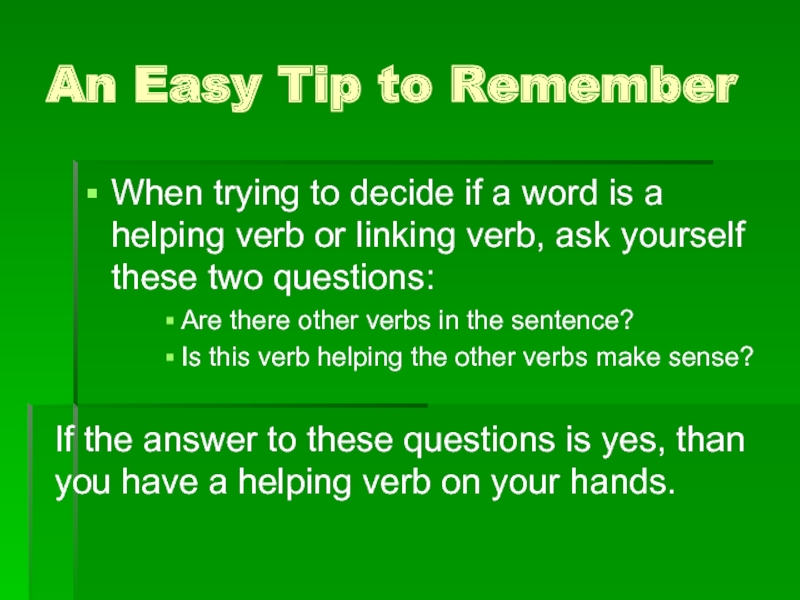
Слайд 14Time to Review
Take some time now to review your notes. If
you have any questions, please be sure to ask.
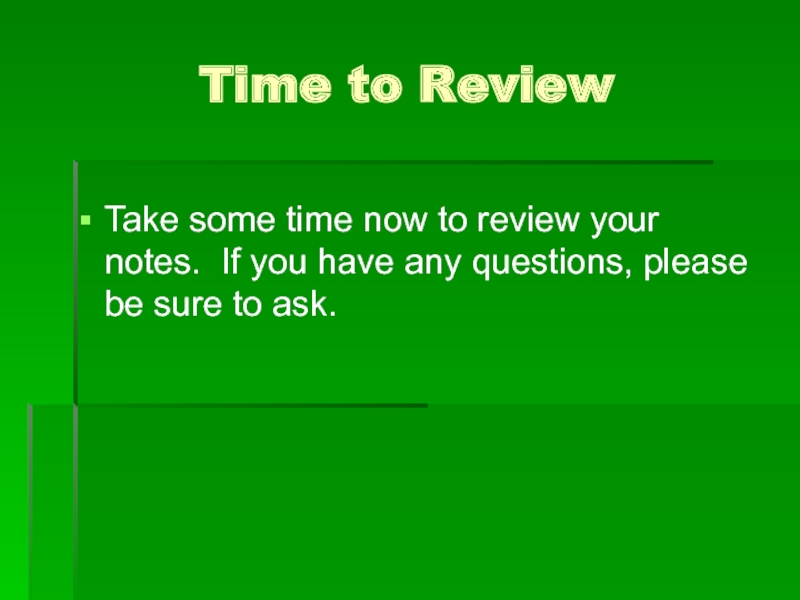
VERBS A verb is a word that shows action, links another word to the subject, helps another verb, or merely indicates existence. An action verb expresses physical or mental action. • sink, swim, scream, shuffle (physical action verbs) • think, see, realize, decide (mental action verbs) An action verb is transitive if it directs action toward someone or something (the direct object); it is intransitive if it does not. • Transitive: Angie played baseball. (played what? baseball)
Identify the verb as mental or physical and transitive or intransitive. Hint: Identify your prepositional phrases first. Your verb is not in them, nor is the direct object. • • • 1. Hansel and Gretel wandered through the forest. 2. My mother studied Latin in high school. 3. Our team built the best sand castle. 4. David wrote an excellent essay. 5. Darin hoped for a new car. 6. I planted flowers this weekend. 7. The monkeys swung from tree to tree. 8. After their long hikers ate greedily. 9. The teacher carefully considered the question.
LINKING VERBS • A linking verb does not express action. It links a word in the predicate to the subject.
Identify the linking verb and circle the words in the sentence that it links. Remember to mark out prepositions first. 1. The fans were eager for a win. 2. Some of the council members were angry about the taxes. 3. One of the boxes was completely empty. 4. The old barn smelled musty. 5. Helena is our new president. 6. The patient was a man with great courage. 7. The play was a huge success. 8. The principal is always considerate of her staff. 9. Peter Pan stayed a child all his life. 10. That style looks good on you
A helping verb helps the main verb to make a statement.
Add Helping verbs to the following sentences. • 1. I ________studying for two hours. • 2. Who _______running for student council? • 3. We_____ never ______done it without your help. • 4. Dinner _____not be ready for a while. • 5. We _______prepared more food. • 6. The guests ____________ arriving at any moment. • 7. Phil ____ never ____ repeated that remark. • 8. Will your sister ______ starting college this fall? • 9. __________ you put it?
Record in Grammar Section: • • A verb phrase is a main verb and its helping verbs. • – We should have studied for the final. • • A verb phrase can be interrupted by adverbs. • – He should easily complete the test on time. • • The subject of an interrogative sentence usually interrupts the verb phrase. • – Have you seen the play?
Identify the verb phrase in the following sentences. • Explorers have been faced with many obstacles. • They may spend days looking for a shallow place in a river to cross safely. • Canyons and ravines can often not be crossed at all. • Instead, people must travel long distances around them. • Mountain ranges have always presented a challenge. • Explorers must search for a pass through them. • Some explorers searching for mountain passes have been killed by storms, severe cold, or land slides. • Desert heat can also be dangerous. • Even insects can be a hazard.
Verb Assessment 1. Create a sentence with a transitive action verb. 2. Create a sentence with a linking verb. 3. Create a sentence utilizing helping verbs. 4. Create a sentence with a state of being verb. 5. Create a sentence with a intransitive action verb. • Now go back to your sentences and underline your verb twice, and your subject once, box any prepositional phrases. • • •











